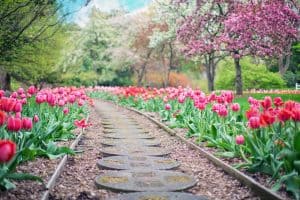A Guide To Creating An Eco-Friendly Garden
If you want to improve a garden space but also want to implement eco-friendly features, then take a look at our following guide. We’ll be walking you through the different ways you can help ensure your garden is doing its bit to help support wildlife and your impact on the environment. Keep reading to learn more.
Creating Wildlife Areas
Creating wildlife areas in a garden provides a sanctuary for local wildlife and contributes to ecological balance. You could plant native trees, shrubs, and flowers – all of which can provide food, shelter, and nesting sites for birds, bees, butterflies, and other insects. Incorporate a water feature like a birdbath or small pond to attract wildlife.
Leave some areas of the garden untamed, allowing wildflowers to grow and providing hiding spots for creatures. Avoid using chemical pesticides and create a diverse range of plantings to support a variety of species. By creating wildlife-friendly areas, you can promote biodiversity and enjoy the beauty of nature in your garden.
Adding fencing from a timber merchant can help to create zones within your garden and reduce disturbance or damage to wildlife habitats.
Growing Your Own Food
Growing your own food offers numerous environmental benefits. Firstly, it reduces the carbon footprint associated with commercial food production, transportation, and packaging. Homegrown food eliminates the need for long-distance shipping and excessive packaging waste.
Secondly, growing food organically reduces the use of synthetic fertilisers and pesticides, protecting soil health and biodiversity. It also promotes sustainable agricultural practices and reduces water pollution.
Additionally, home gardens can serve as habitats for pollinators and beneficial insects, contributing to ecosystem health. Growing your own food encourages a connection with nature, fostering an appreciation for the environment and sustainable living practices.
Creating A Compost Heap
Interesting in contributing to a more sustainable lifestyle? Why not create a compost heap? Creating a compost heap is a simple and effective way to reduce organic waste and improve soil. Select a suitable location in your garden that receives partial sunlight. Layer your compost pile with brown materials (like dried leaves, twigs, or newspaper) and green materials (such as fruit and vegetable scraps, coffee grounds, or grass clippings).
Turn the pile regularly to aerate it and speed up decomposition. Avoid adding meat, dairy, or oily foods that can attract pests. Over time, the organic matter will break down into nutrient-rich compost that can be used to enrich your garden soil, promoting healthy plant growth and reducing the need for chemical fertilisers.
Upcycling Garden Furniture
Upcycling garden furniture is a great way to help reduce waste and use existing pieces and materials. Try purchasing garden furniture second-hand and upcycling it yourself with new paint or repairs. You could also use less conventional pieces, such as wooden pallets, to create your own garden furniture, such as benches and tables.
Not only does upcycling help reduce waste, but it also means you can save money, too, as new garden furniture can be expensive to buy and tends to weather quickly.
Mulching Soil
Mulching soil offers a multitude of benefits for gardeners and the environment. Firstly, it conserves soil moisture by reducing evaporation, helping to keep plants hydrated and reducing the need for frequent watering. Secondly, mulch acts as an insulating layer, regulating soil temperature and protecting plants from extreme heat or cold.
It suppresses weed growth, minimising competition for nutrients and reducing the need for manual weeding or herbicides. Mulch also helps prevent soil erosion by acting as a protective barrier against heavy rain and wind. Additionally, organic mulch decomposes over time, enriching the soil with organic matter and improving its fertility, structure, and overall health.
Wildlife-Friendly Features
Adding wildlife-friendly features to a garden provides habitats and resources for local wildlife, contributing to biodiversity and ecological balance. Start by planting native plants that provide food, shelter, and nesting sites for birds, butterflies, and beneficial insects. Install bird feeders, bird baths, or small ponds to attract birds and provide water sources.
Incorporate flowering plants that attract pollinators like bees and butterflies. Create brush piles or leave some garden areas untamed to provide hiding spots for small animals. Hedgehog boxes and creating holes in fencing for them to travel through are great ways to help out a species increasingly threatened by urbanisation.
Water Conservation
Conserving water in a garden is essential for environmentally sustainable gardening. Install a rainwater harvesting system to collect and store rainwater for irrigation. Use drip irrigation or soaker hoses instead of overhead sprinklers to minimise water loss through evaporation.
Group plants with similar water needs together to avoid overwatering. Apply a layer of organic mulch around plants to retain soil moisture and reduce water evaporation. Water plants during the cooler parts of the day to minimise water loss due to evaporation. Regularly monitor soil moisture levels to ensure plants receive adequate water.
